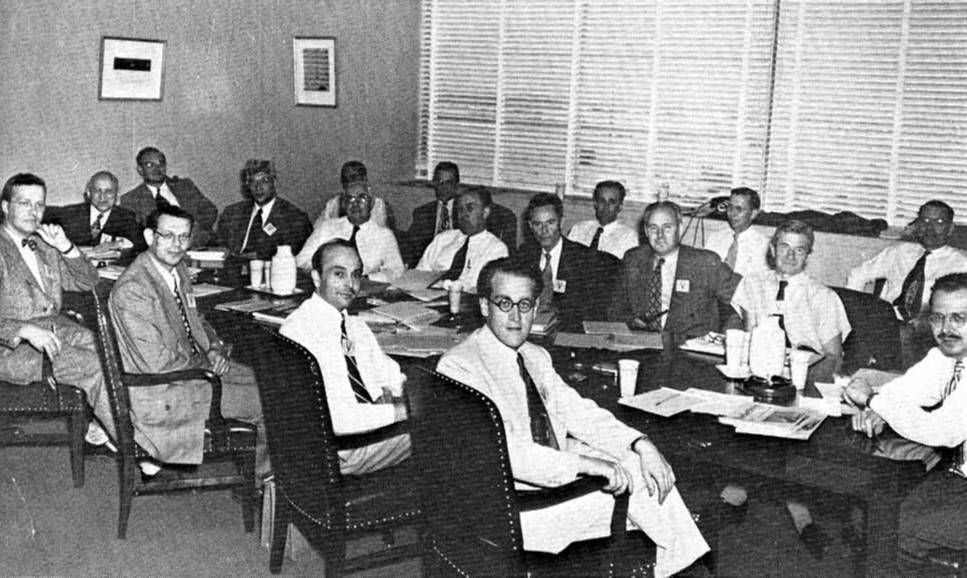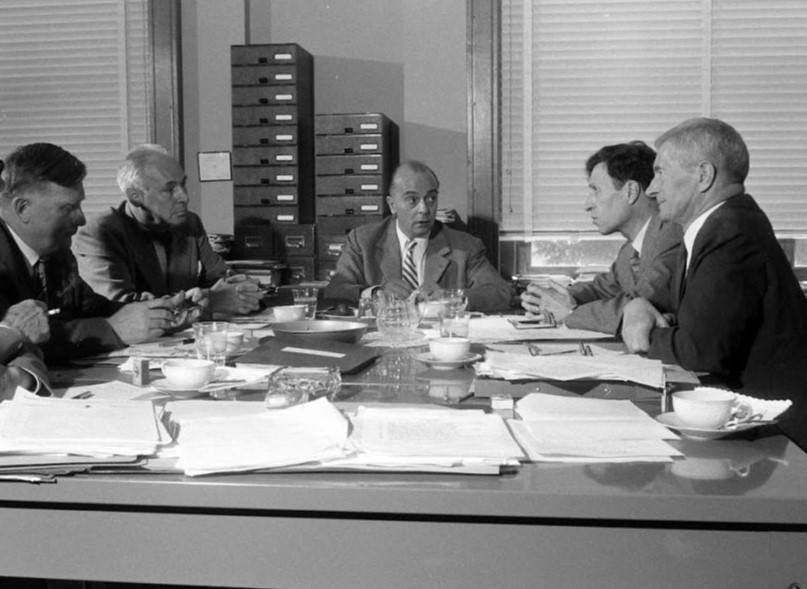At the height of the Cold War in the 1950s, scientists established the International Geophysical Year (IGY), an international effort for a comprehensive study of the Earth, its poles, its atmosphere, and its interactions with the Sun. The 18-month effort took place in 1957 and 1958. Advances in rocket technology led to the promise that artificial Earth satellites could add to the scientific observations of the planet. The United States and the Soviet Union publicly announced plans to launch satellites during the IGY. Seven years of planning led to coordinated activities in 11 science disciplines by participating scientists in 67 nations. The large volume of information gathered during the IGY required the establishment of World Data Centers to make the results widely accessible.


Left: The house of physicist James A. and Abigail Van Allen in Silver Spring, Maryland.
Image credit: Courtesy Physics Today. Right: First science planning meeting for
a proposed third International Polar Year, held in Inyokern, California, in May 1950.
As with many great plans, the idea for the IGY began in a humble setting. On April 5, 1950, physicist James A. Van Allen of the Johns Hopkins University’s Applied Physics Laboratory and his wife Abigail hosted a dinner party at their house in Silver Spring, Maryland, for several prominent geophysicists. Physicist Lloyd V. Berkner proposed the idea of a third International Polar Year (IPY), based on the model of the first (1882-3) and second (1932-3) IPYs, international collaborations that sought to increase our knowledge of the Earth’s polar regions. The other scientists present immediately liked the idea and began soliciting support from their respective organizations. Within a month, a group of scientists met in California to begin planning the scientific studies for the third IPY. During the course of several more planning meetings, a consensus emerged that this international endeavor should not limit itself to just studying the Earth’s poles. In May 1952, Berkner and British geophysicist Sydney Chapman, also present at the Van Allen dinner party, formally proposed the idea of a greatly expanded International Geophysical Year (IGY) to the International Council of Scientific Unions (ICSU). The ICSU endorsed the idea and on May 16, 1952, established the Special Committee for the International Geophysical Year, better known by its French acronym CSAGI. The first official meeting of the CSAGI took place in Brussels on Oct. 13, 1952, to begin planning the IGY for the 18-month period from July 1, 1957, to December 31, 1958, to encompass an entire year in both of Earth’s hemispheres. The time period not only marked the 25th anniversary of the second IPY but coincided with the next expected maximum activity phase of the Sun’s 11-year cycle. The scope of the IGY encompassed 11 different Earth sciences: aurora and airglow, cosmic rays, geomagnetism, glaciology, gravity, ionospheric physics, precision mapping, meteorology and radiation, oceanography, seismology, solar activity. Two additional disciplines dealt with the development of rockets and satellites and the establishment of regular and special World Days for synchronized global observations. The large volume of information from the collective activities led to the establishment of World Data Centers to make the results available to all participants.


Left: British physicist and Nobel Prize laureate Edward V. Appleton, left, and Belgian
geophysicist Marcel Nicolet, during an early planning meeting in Brussels in September
1950. Right: A meeting of the Special Committee for the International Geophysical
Year, known by its French acronym CSAGI, in Brussels in June 1957, included
Vladimir V. Beloussov of the Soviet Union, left, Lloyd V. Berkner of the
United States, Nicolet, Jean Coulomb of France, and Sydney Chapman
of the United Kingdom.
Although the early 1950s marked the height of the Cold War, with the Korean War raging until June 1953, international scientific collaboration appeared somewhat immune to geopolitics. The initial ranks of 23 nations participating in the IGY eventually expanded to 67. The Soviets, initially attending the planning meetings as observers, grew to fully embrace the spirit of the IGY to showcase their scientific and technological prowess. When the United States announced on July 29, 1955, that it planned to launch artificial Earth satellites to add to the science return from the IGY, the Soviet Union responded four days later that it would do the same. The United States had ongoing satellite efforts managed by its military branches and the Soviet Union formally approved a single program on Jan. 30, 1956. America made its plans and progress public while the Soviets worked in secret and therefore had an edge in upstaging U.S. efforts.


Left: Official symbol of the International Geophysical Year (IGY). Right: White House
press release announcing the United States plan to launch an Earth orbiting satellite
during the IGY. Image credit: Courtesy Eisenhower Presidential Library.
To be continued…




























